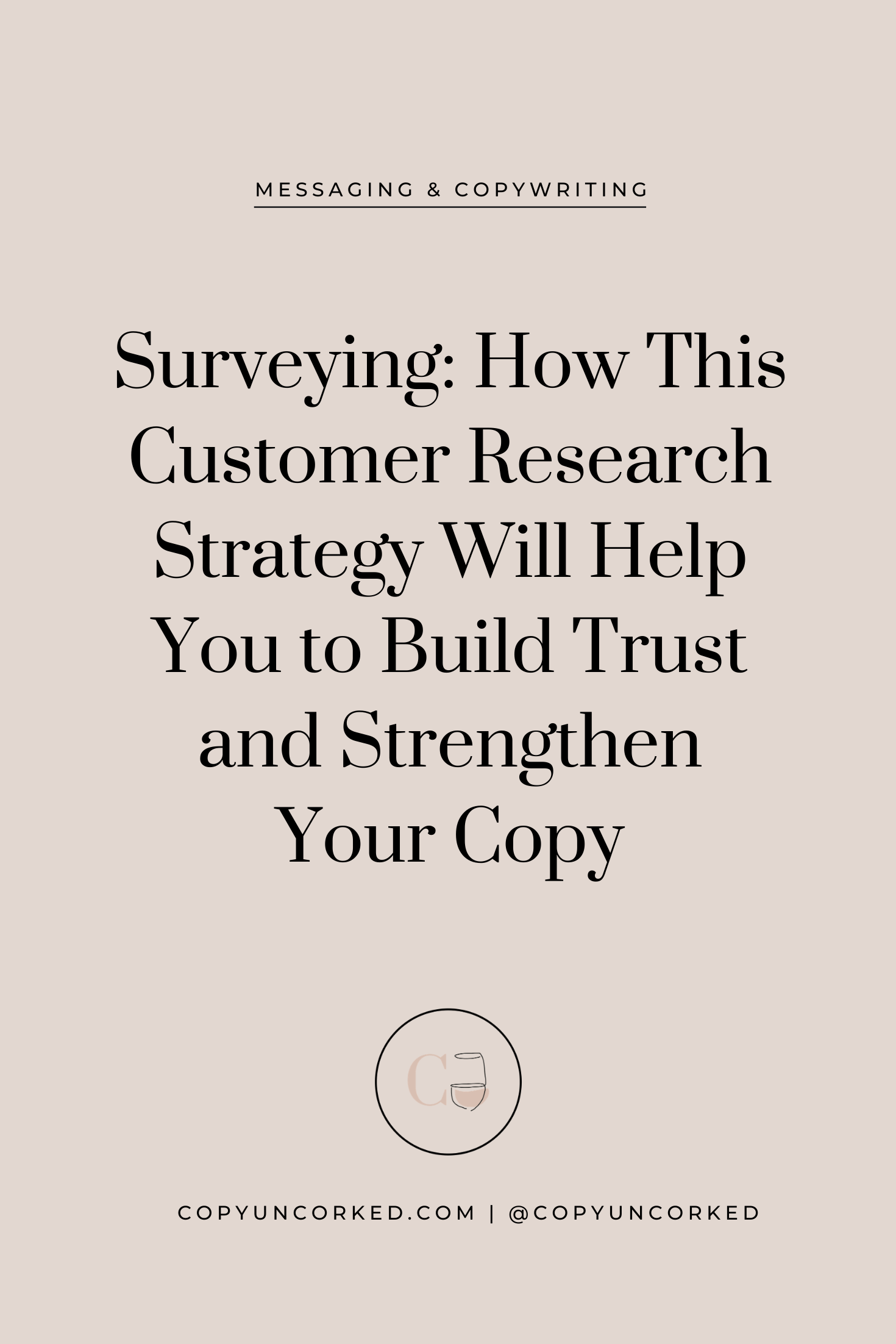Surveying: How This Customer Research Strategy Will Help You to Build Trust and Strengthen Your Copy
April 29, 2020
Customer research is the foundation of every business and crucial for growth in all aspects of your brand – from developing your offerings, crafting your copy, creating educational products, and of course, enhancing the experience you create for your clients/customers.
Not only does customer research build trust in your brand and create a loyal community, but it also helps you to write more effective copy that ultimately grows your business. Further, it helps you to stand out from your competitors because (*big differentiator!*) – you’ve done your due diligence.
So today we’re going to talk about an often-overlooked, under-loved strategy for conducting customer research: Surveying.
This valuable strategy allows you to gain a better understanding of your target audience’s wants and needs, so you can, in turn, improve your product offerings and standard of service.
The feedback you gain through surveying is gold as a small business owner. A survey is a direct channel from your clientele on their viewpoints! If done well, it allows you to evaluate your success, develop a rapport with your clients, and you may even come up with a new idea for a product or service based on their feedback.
Sound good? Let’s get into it…
Tools to Use
A survey can be as simple as a questionnaire using a Google Form, but we recommend taking it one step further and using the platform, Typeform. (We don’t have an affiliate link in here or anything, we just use it ourselves and love it!)
This tool offers both a free/trial version and a paid version. We used the free version for a while, but have recently upgraded as our surveying has gotten more robust and our audience size has increased. You can get up to three forms (read: surveys) to start, but then from there, it goes to $35/mo. You can also upgrade to premium if you have a large audience or want the option to have what Typeform refers to as a “logic jump”, where it skips to specific questions, based on people’s answers.
We love Typeform for the clean interface, the ability to brand the survey with your logo and embed it into a web page. Also, the results and data that it provides is detailed and easy to synthesize.
If you’re looking to keep costs to zero and you’re just more comfortable with Google products, you can certainly use Google Forms or any other program of your choosing.
Distribution
Distributing your survey is where you can get creative! But to reach your target audience as a whole, your email list is the go-to channel. (If you’re thinking to yourself, what list!? Start one already!) If you’re looking for a broader audience, you can share it across your social channels and even add it as a banner to your website.
If you want to get more niche, send it to a group of people within your email list, for example, targeting one particular segment like “Wedding Photographers” or “Purchased Course”.
Additionally, don’t be afraid to send it out more than once. People don’t always jump at the first opportunity. Run it for a fair amount of time but put a deadline on it so they don’t have forever to just keep putting it off.
Just be sure to tailor it to the audience you see fit as much as possible, so it allows you to gain the most valuable results for the questions you are asking.
Which leads us to our next point…
Crafting Your Survey
Remember in high school science class when you had to make a hypothesis going into an experiment? Surveying is kind of like that, too. You want to go into it with an idea of what you *think* the answers may be, and allow the data to reveal the truth.
In creating your survey, you also want to really think through the audience you’re targeting and how you can tailor the questions to that audience specifically.
You’re essentially looking to gain the insight you otherwise wouldn’t be aware of without asking!
For example, start by thinking:
What don’t you know or what aren’t you sure of? How could your offering be improved? What are their preferences when it comes to formatting, platform, and delivery?
You want your audience to feel as if they’re co-creating something with you rather than just providing feedback, so structure your questions based on their needs, desires, and experiences.
i.e.: What is working about what they’ve tried so far? What isn’t?
Jot everything down as it comes to you. Remember, if a question isn’t asked, you’ll never get an answer. You can eliminate later, but this initial piece of crafting your survey is all about brainstorming – then editing, organizing, and clarifying.
Once you have a clear picture of what you’re asking your audience and a set of questions, make sure each question sounds crystal clear. The last thing you want is to confuse your audience by asking two questions in one, so really go over your questions with a fine-toothed comb for clarity and precision.
We recommend using multiple choice and short answers at the beginning of your survey to get people started, then slowly ease into quick or longer responses.
One important thing to note, your survey can be as short as it needs to be. You’d rather people finish your survey than stop halfway and get too sick of taking it!
Unless you’re surveying to get a better picture of your audience’s demographics, don’t waste questions at the beginning asking those sorts of details. Just ask the must-knows like: Are you a service provider or a product-based business? If it’s not totally relevant to what you’re trying to uncover, or you already have a pretty clear picture, skip it and get right into the crux of the surveying.
Also, think about the length of your survey in comparison to what you’re offering or asking. Realistically, most people are not going to answer 30 questions for a $20 digital product. However, if the product/service/event is more involved, a slightly longer survey makes sense due to the investment at hand (i.e. a $10K mastermind), so plan questions accordingly.
Anonymity & Incentive
Although you can (and should) make your survey responses anonymous, we like to give the option to input the audience’s contact information if they’re willing and offer an incentive for taking it. This can be related to the new product/service/event you’re gauging feedback on or as simple as a product discount, a giveaway, or an Amazon gift card even!
Most importantly, you want to show your audience the benefit of taking the survey outside of the incentive.
WHY should they [your audience] care what you’re creating and what kind of a future are you creating that you want them to be a part of?
Just like with copywriting, you want to show your audience that you’re thinking of how this question/product/service is relevant to their life.
Keep them in the loop about the results, take their opinions into account, and implement their responses into your new product/service/event! Creating the trust of your audience will allow for better results each time you survey your audience down the road.
Mini-Surveying
If all this sounds too much for the current state of your business or you really just have one question you want to ask your audience, you can create a mini-survey, which can be asked via a simple Instagram poll.
Additionally, you can add a one-question thank you survey to a landing page after a new subscriber has subscribed to your list or a new client has purchased a product in your online shop.
If you have a few more questions for the new subscriber or purchaser, send product-specific follow-up emails asking for their feedback, either personally or with an embedded Typeform survey.
The benefit of mini-surveying shows your audience you’re engaging them in a meaningful way by expressing concern and a real desire to meet their needs, which will continue building that ever-important trust factor we’ve been talking about!
Compiling the Data & Synthesizing the Results
Here comes the hard yet fun part…ingesting all the valuable information you’ve just received! Don’t be overwhelmed! We recommend tackling this part in batches so you can really dive deeper into the results of each question.
Read through it first. Just try to get a general feel for the consensus – if there even was one! Take the time to review each free response, without judgment. Just “listen”.
Then, think about how you want to export, organize, and further implement the results. We like to download the results straight from Typeform and then organize them into a Google Sheet of our own that categorizes things out in columns.
For example, you can have a column for those expressing a problem or pain point, those expressing an idea you want to consider, those expressing an idea you most likely won’t implement, etc.
The cliche notion of “take things with a grain of salt” applies here, too. Only a small percentage of your audience may have responded, so just remember, that although you may have gained some good insight, it doesn’t necessarily tell the whole picture.
This is where deeper customer interviews can come into play, but we’ll get into that more in a future post.
Take what you now know to refine or create your product/service and get even more specific and accurate with your sales copy!
Want to get a feel for a survey in action?
We’re currently running THIS ONE, in order to obtain feedback about how to structure our upcoming website copywriting group program. If writing your own website copy has been a source of frustration and procrastination, and a course/guided group program sounds like something that would interest you, we’d love for you to weigh in!
We hope you gained some worthwhile insight into surveying. As always we’re here to help, so feel free to leave your questions in the comments or check out our services and get in touch here.
Cheers,
Kaitlyn

Read the Comments +
-
[…] out our post on Surveying and customer research to learn more about this and better understand your target audience’s […]





[…] out our post on Surveying and customer research to learn more about this and better understand your target audience’s […]